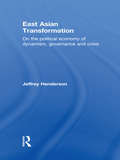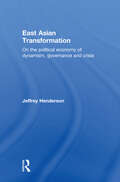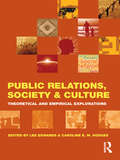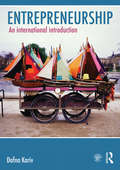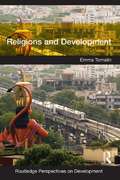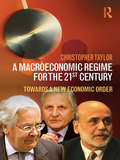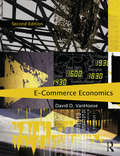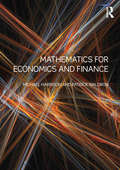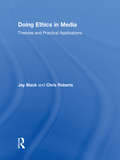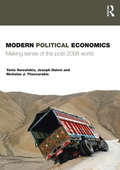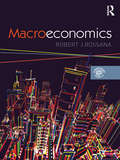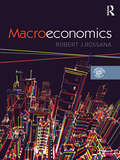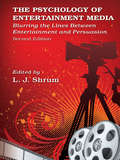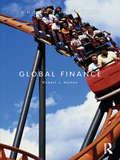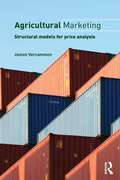- Table View
- List View
East Asian Transformation: On the Political Economy of Dynamism, Governance and Crisis
by Jeffrey HendersonFrom the re-emergence of Japan as an industrial power in the 1950s through to the contemporary rise of China as a potential economic and political behemoth, the story of East Asian development has been central to any serious analysis of the dynamics and trajectory of the global political economy. Integrated into a coherent, critical narrative, this book examines key political-economic and social dynamics that helped forge the ‘miracle’ economies of East Asia and continue to drive them forward in the volatile circumstances of our current epoch. It analyses the relation between the state and markets; the changing nature of economic governance and its relation to inequality; and the rise of China and its international consequences. Historically informed and comparative in nature, the book contributes to the analysis of the transformations of Japan, Hong Kong, South Korea, Taiwan, Singapore, Malaysia and China, and is the first to cover the ground in one volume. Written by a leading analyst of East Asian development, the book engages with the relevant issues and debates, in an open, non-technical language, making it useful as an advanced textbook not only for East Asian studies, but more generally in international political economy and development studies.
East Asian Transformation: On the Political Economy of Dynamism, Governance and Crisis (International Political Economy Ser.)
by Jeffrey HendersonFrom the re-emergence of Japan as an industrial power in the 1950s through to the contemporary rise of China as a potential economic and political behemoth, the story of East Asian development has been central to any serious analysis of the dynamics and trajectory of the global political economy. Integrated into a coherent, critical narrative, this book examines key political-economic and social dynamics that helped forge the ‘miracle’ economies of East Asia and continue to drive them forward in the volatile circumstances of our current epoch. It analyses the relation between the state and markets; the changing nature of economic governance and its relation to inequality; and the rise of China and its international consequences. Historically informed and comparative in nature, the book contributes to the analysis of the transformations of Japan, Hong Kong, South Korea, Taiwan, Singapore, Malaysia and China, and is the first to cover the ground in one volume. Written by a leading analyst of East Asian development, the book engages with the relevant issues and debates, in an open, non-technical language, making it useful as an advanced textbook not only for East Asian studies, but more generally in international political economy and development studies.
Public Relations, Society & Culture: Theoretical and Empirical Explorations
by Lee Edwards Caroline E. M. HodgesHistorically, public relations research has been dominated by organisational interests, treating the profession as a function to help organisations achieve their goals, and focusing on practice and processes first and foremost. Such research is valuable in addressing how public relations can be used more effectively by organisations and institutions, but has tended to neglect the consequences of the practice on the social world in which those organisations operate. This edited collection adds momentum to the emergent interest in the relationship between public relations, society and culture by bringing together a wide range of alternative theoretical and methodological approaches, including anthropology, storytelling, pragmatism and Latin American studies. The chapters draw on insights from a variety of disciplines including sociology, cultural studies, post-colonialism, political economy, ecological studies, feminism and critical race theory. Empirical contributions illustrate theoretical arguments with narratives and interview extracts from practitioners, resulting in an engaging text that will provide inspiration for scholars and students to explore public relations in new ways. Public Relations, Society and Culture makes an essential contribution to a range of scholarly fields and illustrates the relevance of public relations to matters beyond its organisational function. It will be highly useful to students and scholars of public relations as well as cultural studies, ethnicity/‘race’ communication, media studies, development communication, anthropology, and organisational communication. This insightful book will make a significant contribution to debates about the purpose and practice of public relations in the new century.
Public Relations, Society & Culture: Theoretical and Empirical Explorations
by Lee Edwards Caroline E. M. HodgesHistorically, public relations research has been dominated by organisational interests, treating the profession as a function to help organisations achieve their goals, and focusing on practice and processes first and foremost. Such research is valuable in addressing how public relations can be used more effectively by organisations and institutions, but has tended to neglect the consequences of the practice on the social world in which those organisations operate. This edited collection adds momentum to the emergent interest in the relationship between public relations, society and culture by bringing together a wide range of alternative theoretical and methodological approaches, including anthropology, storytelling, pragmatism and Latin American studies. The chapters draw on insights from a variety of disciplines including sociology, cultural studies, post-colonialism, political economy, ecological studies, feminism and critical race theory. Empirical contributions illustrate theoretical arguments with narratives and interview extracts from practitioners, resulting in an engaging text that will provide inspiration for scholars and students to explore public relations in new ways. Public Relations, Society and Culture makes an essential contribution to a range of scholarly fields and illustrates the relevance of public relations to matters beyond its organisational function. It will be highly useful to students and scholars of public relations as well as cultural studies, ethnicity/‘race’ communication, media studies, development communication, anthropology, and organisational communication. This insightful book will make a significant contribution to debates about the purpose and practice of public relations in the new century.
Entrepreneurship: An International Introduction
by Dafna KarivEntrepreneurship means different things to different people, but the entrepreneurial personality is a critical success factor to any new business. These traits are also increasingly in great demand at established multinational corporations. This groundbreaking textbook differs from its competitors by placing an emphasis both on the core processes and practices of entrepreneurship, as well as demonstrating the impact of complex, local environments in shaping the processes of entrepreneurship. Topics include: Main processes of entrepreneurial venture creation, innovation and growth Operational steps characterizing processes of entrepreneurship Establishing and realizing entrepreneurial ventures Core processes and practices of entrepreneurship With case studies and interviews with entrepreneurs from across the globe, Entrepreneurship's international approach makes it stand out from other titles, providing students and practitioners alike with a unique perspective on this subject. A companion website featuring: a lecturer's guide, with extra assignments and links to videos, PowerPoint slides for teaching uses and a questionnaire with detailed feedback for students, is available at: http://cw.routledge.com/textbooks/9780415561204.
Entrepreneurship: An International Introduction (New Horizons In Entrepreneurship Ser.)
by Dafna KarivEntrepreneurship means different things to different people, but the entrepreneurial personality is a critical success factor to any new business. These traits are also increasingly in great demand at established multinational corporations. This groundbreaking textbook differs from its competitors by placing an emphasis both on the core processes and practices of entrepreneurship, as well as demonstrating the impact of complex, local environments in shaping the processes of entrepreneurship. Topics include: Main processes of entrepreneurial venture creation, innovation and growth Operational steps characterizing processes of entrepreneurship Establishing and realizing entrepreneurial ventures Core processes and practices of entrepreneurship With case studies and interviews with entrepreneurs from across the globe, Entrepreneurship's international approach makes it stand out from other titles, providing students and practitioners alike with a unique perspective on this subject. A companion website featuring: a lecturer's guide, with extra assignments and links to videos, PowerPoint slides for teaching uses and a questionnaire with detailed feedback for students, is available at: http://cw.routledge.com/textbooks/9780415561204.
Religions and Development
by Emma TomalinReligion has been excluded from development studies for decades. Religious traditions have contributed greatly towards development work, yet major international players have tended to ignore its role. Recent years have shown a noticeable shift in development policy, practice and research to recognize religion as a relevant factor. This text provides a comprehensive insight into different approaches towards the understanding the relationships between religions and development studies, policy and practice. It guides readers through current debates, presenting, explaining and critically evaluating a broad range of literature and locating it within a theoretical context. The text explores the role of religion within development, from positive contributions, such as the important role that many ‘faith-based organizations’ play in education or health care, to more complicated and contested notions of impact, such as religiously inspired violence or gender inequality. The book begins with three background chapters, outlining the relevance of religions for development studies, policy and practice, and introducing the reader to the study of ‘development’ and of ‘religions’. Following these, the focus then shifts to examine a number of thematic areas, including religion, gender and development, and the implications of the ‘rise of religion’ for mainstream development studies, policy and practice in the 21st century. Each chapter contains a range of features to assist undergraduate learning, including learning objectives for each chapter, discussion of key concepts, summaries, discussion questions, further reading and websites. The book also contains over sixty boxed case studies to provide further definition, explanation, and examples of the interactions between religions and development globally. This innovative text presents religions as something that can both obstruct and aid development, encouraging readers to engage critically with the multiple ways that religion impacts on both the conceptualization of development as well the resulting project interventions. This will be of interest to undergraduate, postgraduate students and scholars interested in religious studies, development studies, and the broader study of societies and cultures.
Religions and Development
by Emma TomalinReligion has been excluded from development studies for decades. Religious traditions have contributed greatly towards development work, yet major international players have tended to ignore its role. Recent years have shown a noticeable shift in development policy, practice and research to recognize religion as a relevant factor. This text provides a comprehensive insight into different approaches towards the understanding the relationships between religions and development studies, policy and practice. It guides readers through current debates, presenting, explaining and critically evaluating a broad range of literature and locating it within a theoretical context. The text explores the role of religion within development, from positive contributions, such as the important role that many ‘faith-based organizations’ play in education or health care, to more complicated and contested notions of impact, such as religiously inspired violence or gender inequality. The book begins with three background chapters, outlining the relevance of religions for development studies, policy and practice, and introducing the reader to the study of ‘development’ and of ‘religions’. Following these, the focus then shifts to examine a number of thematic areas, including religion, gender and development, and the implications of the ‘rise of religion’ for mainstream development studies, policy and practice in the 21st century. Each chapter contains a range of features to assist undergraduate learning, including learning objectives for each chapter, discussion of key concepts, summaries, discussion questions, further reading and websites. The book also contains over sixty boxed case studies to provide further definition, explanation, and examples of the interactions between religions and development globally. This innovative text presents religions as something that can both obstruct and aid development, encouraging readers to engage critically with the multiple ways that religion impacts on both the conceptualization of development as well the resulting project interventions. This will be of interest to undergraduate, postgraduate students and scholars interested in religious studies, development studies, and the broader study of societies and cultures.
A Macroeconomic Regime for the 21st Century: Towards a New Economic Order
by Christopher TaylorThe book aims to give non-economists a detailed understanding of how macroeconomic policy works in modern economies, and the issues it faces. The world has recently been through a huge economic crisis and thinking people everywhere have reason to wonder whether something is not seriously wrong with the policy regimes underlying these dramatic events in the major economies, and whether changes should be made. The author reviews the history of the successive regimes tried and found wanting in the second half of the last century and proposes a set of reforms designed to convert the flawed neo-liberal consensus of the 1990s into a durable regime for the present century.
A Macroeconomic Regime for the 21st Century: Towards a New Economic Order
by Christopher TaylorThe book aims to give non-economists a detailed understanding of how macroeconomic policy works in modern economies, and the issues it faces. The world has recently been through a huge economic crisis and thinking people everywhere have reason to wonder whether something is not seriously wrong with the policy regimes underlying these dramatic events in the major economies, and whether changes should be made. The author reviews the history of the successive regimes tried and found wanting in the second half of the last century and proposes a set of reforms designed to convert the flawed neo-liberal consensus of the 1990s into a durable regime for the present century.
eCommerce Economics, Second Edition
by David VanHooseThis second edition of eCommerce Economics addresses the economic issues associated with using computer-mediated electronic networks, such as the Internet, as mechanisms for transferring ownership of or rights to use goods and services. After studying this book, students will recognize problems that arise in the electronic marketplace, such as how to gauge the competitive environment, what products to offer, how to market those products, and how to price those products. They also will understand the conceptual tools required to evaluate the proper scope of public policies relating to electronic commerce. Core topics covered in the book include the underpinning of electronic commerce and the application of basic economic principles, including the theories of perfect and imperfect competition, to the electronic marketplace. Building on this foundation, the book discusses virtual products, network industries, and business strategies and conduct. Additional key topics include Internet advertising, intellectual property rights in a digital environment, regulatory issues in electronic markets, public sector issues, online banking and finance, digital cash, international electronic trade, and the implications of e-commerce for aggregate economic activity.
eCommerce Economics, Second Edition
by David VanHooseThis second edition of eCommerce Economics addresses the economic issues associated with using computer-mediated electronic networks, such as the Internet, as mechanisms for transferring ownership of or rights to use goods and services. After studying this book, students will recognize problems that arise in the electronic marketplace, such as how to gauge the competitive environment, what products to offer, how to market those products, and how to price those products. They also will understand the conceptual tools required to evaluate the proper scope of public policies relating to electronic commerce. Core topics covered in the book include the underpinning of electronic commerce and the application of basic economic principles, including the theories of perfect and imperfect competition, to the electronic marketplace. Building on this foundation, the book discusses virtual products, network industries, and business strategies and conduct. Additional key topics include Internet advertising, intellectual property rights in a digital environment, regulatory issues in electronic markets, public sector issues, online banking and finance, digital cash, international electronic trade, and the implications of e-commerce for aggregate economic activity.
Mathematics for Economics and Finance
by Michael Harrison Patrick WaldronThe aim of this book is to bring students of economics and finance who have only an introductory background in mathematics up to a quite advanced level in the subject, thus preparing them for the core mathematical demands of econometrics, economic theory, quantitative finance and mathematical economics, which they are likely to encounter in their final-year courses and beyond. The level of the book will also be useful for those embarking on the first year of their graduate studies in Business, Economics or Finance. The book also serves as an introduction to quantitative economics and finance for mathematics students at undergraduate level and above. In recent years, mathematics graduates have been increasingly expected to have skills in practical subjects such as economics and finance, just as economics graduates have been expected to have an increasingly strong grounding in mathematics. The authors avoid the pitfalls of many texts that become too theoretical. The use of mathematical methods in the real world is never lost sight of and quantitative analysis is brought to bear on a variety of topics including foreign exchange rates and other macro level issues.
Mathematics for Economics and Finance
by Michael Harrison Patrick WaldronThe aim of this book is to bring students of economics and finance who have only an introductory background in mathematics up to a quite advanced level in the subject, thus preparing them for the core mathematical demands of econometrics, economic theory, quantitative finance and mathematical economics, which they are likely to encounter in their final-year courses and beyond. The level of the book will also be useful for those embarking on the first year of their graduate studies in Business, Economics or Finance. The book also serves as an introduction to quantitative economics and finance for mathematics students at undergraduate level and above. In recent years, mathematics graduates have been increasingly expected to have skills in practical subjects such as economics and finance, just as economics graduates have been expected to have an increasingly strong grounding in mathematics. The authors avoid the pitfalls of many texts that become too theoretical. The use of mathematical methods in the real world is never lost sight of and quantitative analysis is brought to bear on a variety of topics including foreign exchange rates and other macro level issues.
Doing Ethics in Media: Theories and Practical Applications
by Jay Black Chris RobertsDoing Ethics in Media: Theories and Practical Applications is an accessible, comprehensive introduction to media ethics. Its theoretical framework and grounded discussions engage students to think clearly and systematically about dilemmas in the rapidly changing media environment. The 13-chapter text is organized around six decision-making questions— the "5Ws and H" of media ethics. The questions encourage students to articulate the issues; apply codes, policies or laws; consider the needs of stakeholders; sift and sort through conflicting values; integrate philosophic principles; and pose a "test of publicity." Specifically, the questions ask: • What’s your problem? • Why not follow the rules? • Who wins, who loses? • What’s it worth? • Who’s whispering in your ear? • How’s your decision going to look? As they progress through the text, students are encouraged to resolve dozens of practical applications and increasingly complex case studies relating to journalism, new media, advertising, public relations, and entertainment. Other distinctive features include: • Comprehensive materials on classic moral theory and current issues such as truth telling and deception, values, persuasion and propaganda, privacy, diversity, and loyalty. • A user-friendly approach that challenges students to think for themselves rather than imposing answers on them. • Consistent connections between theories and the decision-making challenges posed in the practical applications and case studies. • A companion website with online resources for students, including additional readings and chapter overviews, as well as instructor materials with a test bank, instructor’s manual, sample syllabi and more. www.routledge.com/textbooks/black • A second website with continuously updated examples, case studies, and student writing – www.doingmediaethics.com. Doing Ethics in Media is aimed at undergraduates and graduate students studying media ethics in mass media, journalism, and media studies. It also serves students in rhetoric, popular culture, communication studies, and interdisciplinary social sciences.
Doing Ethics in Media: Theories and Practical Applications
by Jay Black Chris RobertsDoing Ethics in Media: Theories and Practical Applications is an accessible, comprehensive introduction to media ethics. Its theoretical framework and grounded discussions engage students to think clearly and systematically about dilemmas in the rapidly changing media environment. The 13-chapter text is organized around six decision-making questions— the "5Ws and H" of media ethics. The questions encourage students to articulate the issues; apply codes, policies or laws; consider the needs of stakeholders; sift and sort through conflicting values; integrate philosophic principles; and pose a "test of publicity." Specifically, the questions ask: • What’s your problem? • Why not follow the rules? • Who wins, who loses? • What’s it worth? • Who’s whispering in your ear? • How’s your decision going to look? As they progress through the text, students are encouraged to resolve dozens of practical applications and increasingly complex case studies relating to journalism, new media, advertising, public relations, and entertainment. Other distinctive features include: • Comprehensive materials on classic moral theory and current issues such as truth telling and deception, values, persuasion and propaganda, privacy, diversity, and loyalty. • A user-friendly approach that challenges students to think for themselves rather than imposing answers on them. • Consistent connections between theories and the decision-making challenges posed in the practical applications and case studies. • A companion website with online resources for students, including additional readings and chapter overviews, as well as instructor materials with a test bank, instructor’s manual, sample syllabi and more. www.routledge.com/textbooks/black • A second website with continuously updated examples, case studies, and student writing – www.doingmediaethics.com. Doing Ethics in Media is aimed at undergraduates and graduate students studying media ethics in mass media, journalism, and media studies. It also serves students in rhetoric, popular culture, communication studies, and interdisciplinary social sciences.
Modern Political Economics: Making Sense of the Post-2008 World
by Yanis Varoufakis Joseph Halevi Nicholas TheocarakisOnce in a while the world astonishes itself. Anxious incredulity replaces intellectual torpor and a puzzled public strains its antennae in every possible direction, desperately seeking explanations for the causes and nature of what just hit it. 2008 was such a moment. Not only did the financial system collapse, and send the real economy into a tailspin, but it also revealed the great gulf separating economics from a very real capitalism. Modern Political Economics has a single aim: To help readers make sense of how 2008 came about and what the post-2008 world has in store. The book is divided into two parts. The first part delves into every major economic theory, from Aristotle to the present, with a determination to discover clues of what went wrong in 2008. The main finding is that all economic theory is inherently flawed. Any system of ideas whose purpose is to describe capitalism in mathematical or engineering terms leads to inevitable logical inconsistency; an inherent error that stands between us and a decent grasp of capitalist reality. The only scientific truth about capitalism is its radical indeterminacy, a condition which makes it impossible to use science's tools (e.g. calculus and statistics) to second-guess it. The second part casts an attentive eye on the post-war era; on the breeding ground of the Crash of 2008. It distinguishes between two major post-war phases: The Global Plan (1947-1971) and the Global Minotaur (1971-2008). This dynamic new book delves into every major economic theory and maps out meticulously the trajectory that global capitalism followed from post-war almost centrally planned stability, to designed disintegration in the 1970s, to an intentional magnification of unsustainable imbalances in the 1980s and, finally, to the most spectacular privatisation of money in the 1990s and beyond. Modern Political Economics is essential reading for Economics students and anyone seeking a better understanding of the 2008 economic crash.
Modern Political Economics: Making Sense of the Post-2008 World
by Yanis Varoufakis Joseph Halevi Nicholas TheocarakisOnce in a while the world astonishes itself. Anxious incredulity replaces intellectual torpor and a puzzled public strains its antennae in every possible direction, desperately seeking explanations for the causes and nature of what just hit it. 2008 was such a moment. Not only did the financial system collapse, and send the real economy into a tailspin, but it also revealed the great gulf separating economics from a very real capitalism. Modern Political Economics has a single aim: To help readers make sense of how 2008 came about and what the post-2008 world has in store. The book is divided into two parts. The first part delves into every major economic theory, from Aristotle to the present, with a determination to discover clues of what went wrong in 2008. The main finding is that all economic theory is inherently flawed. Any system of ideas whose purpose is to describe capitalism in mathematical or engineering terms leads to inevitable logical inconsistency; an inherent error that stands between us and a decent grasp of capitalist reality. The only scientific truth about capitalism is its radical indeterminacy, a condition which makes it impossible to use science's tools (e.g. calculus and statistics) to second-guess it. The second part casts an attentive eye on the post-war era; on the breeding ground of the Crash of 2008. It distinguishes between two major post-war phases: The Global Plan (1947-1971) and the Global Minotaur (1971-2008). This dynamic new book delves into every major economic theory and maps out meticulously the trajectory that global capitalism followed from post-war almost centrally planned stability, to designed disintegration in the 1970s, to an intentional magnification of unsustainable imbalances in the 1980s and, finally, to the most spectacular privatisation of money in the 1990s and beyond. Modern Political Economics is essential reading for Economics students and anyone seeking a better understanding of the 2008 economic crash.
Macroeconomics
by Robert J. RossanaResearch in macroeconomics in the last thirty years has featured, almost exclusively on two characteristics: an emphasis on the microfoundations of macroeconomics and secondly, intertemporal economics, that is, the behavior of economic actors over time. Curiously, textbooks in intermediate macroeconomics have been very slow to adopt these traits. The aim of this book is to bring intermediate instruction in macroeconomics fully into line with the direction taken by the research community. Key hallmarks of the text include: a full introduction to the microfoundations of consumption and investment a complete model of the labor market with profit maximization for firms to determine labor demand and a utility maximization model to determine labor supply an analysis of the Baumol-Tobin model to determine money demand accompanied by a discussion of traditional money supply Possessing a full range of additional learning features including a companion website, test bank and instructor’s manual, the book takes an international view of macroeconomics with case studies and examples from the United States and beyond.
Macroeconomics
by Robert J. RossanaResearch in macroeconomics in the last thirty years has featured, almost exclusively on two characteristics: an emphasis on the microfoundations of macroeconomics and secondly, intertemporal economics, that is, the behavior of economic actors over time. Curiously, textbooks in intermediate macroeconomics have been very slow to adopt these traits. The aim of this book is to bring intermediate instruction in macroeconomics fully into line with the direction taken by the research community. Key hallmarks of the text include: a full introduction to the microfoundations of consumption and investment a complete model of the labor market with profit maximization for firms to determine labor demand and a utility maximization model to determine labor supply an analysis of the Baumol-Tobin model to determine money demand accompanied by a discussion of traditional money supply Possessing a full range of additional learning features including a companion website, test bank and instructor’s manual, the book takes an international view of macroeconomics with case studies and examples from the United States and beyond.
The Psychology of Entertainment Media: Blurring the Lines Between Entertainment and Persuasion
by L. J. ShrumIn this volume, psychologists and communication experts present theory on understanding and predicting how learning occurs through media consumption. As the impact of traditional advertising has declined over the last couple of decades, marketers have scrambled to find other ways to effectively communicate with consumers. Among other approaches, marketers have utilized various forms of product integration. Product integration is mixing a commercial message in with the non-commercial message via TV, movie, video, and other entertainment venues. This book will be of interest to students and researchers in psychology, marketing, communication, advertising, and consumer behavior.
The Psychology of Entertainment Media: Blurring the Lines Between Entertainment and Persuasion
by L. J. ShrumIn this volume, psychologists and communication experts present theory on understanding and predicting how learning occurs through media consumption. As the impact of traditional advertising has declined over the last couple of decades, marketers have scrambled to find other ways to effectively communicate with consumers. Among other approaches, marketers have utilized various forms of product integration. Product integration is mixing a commercial message in with the non-commercial message via TV, movie, video, and other entertainment venues. This book will be of interest to students and researchers in psychology, marketing, communication, advertising, and consumer behavior.
Global Finance (Shortcuts)
by Robert J. HoltonWritten under the shadow of the global financial crisis, this book charts the current shape of global finance and tries to explain why the crisis arose – and what can be done about it. Economics alone cannot fully explain how global finance operates, and why it is so crisis prone. Global Finance offers a wider approach in three key ways, by: setting markets and financial market failure in a historical context bringing politics and culture back into the analysis of global finance drawing on the latest thinking by sociologists of economic life. With a convincing argument for better regulation of markets, Robert Holton provides a fascinating insight into the volatile and often misunderstood world of global finance. This is a key text for undergraduate students of sociology, economics, business, and politics, as well as being an incisive, informative read for anyone with an interest in this topical issue.
Global Finance (Shortcuts)
by Robert J. HoltonWritten under the shadow of the global financial crisis, this book charts the current shape of global finance and tries to explain why the crisis arose – and what can be done about it. Economics alone cannot fully explain how global finance operates, and why it is so crisis prone. Global Finance offers a wider approach in three key ways, by: setting markets and financial market failure in a historical context bringing politics and culture back into the analysis of global finance drawing on the latest thinking by sociologists of economic life. With a convincing argument for better regulation of markets, Robert Holton provides a fascinating insight into the volatile and often misunderstood world of global finance. This is a key text for undergraduate students of sociology, economics, business, and politics, as well as being an incisive, informative read for anyone with an interest in this topical issue.
Agricultural Marketing: Structural Models for Price Analysis
by James VercammenThe price of food has become very volatile in recent years for a variety of reasons, including a strengthened connection between the prices of agricultural commodities and other commodities such as oil and metals, more volatile production due to more frequent droughts and floods, and a rising demand for biofuels. Understanding the determinants of agricultural commodity prices and the connections between prices has become a high priority for academics and applied economists who are interested in agricultural marketing and trade, policy analysis and international rural development. This book builds on the various theories of commodity price relationships in competitive markets over space, time and form. It also builds on the various theories of commodity price relationships in markets that are non-competitive because processing firms exploit market power, private information distorts commodity bidding, and bargaining is required to establish prices when the marketing transaction involves a single seller and buyer. Each chapter features a spreadsheet model to analyze a particular real-world case study or plausible scenario, and issues considered include: the reasons for commodity price differences across regions the connection between the release of information and the rapid adjustment in a network of commodity prices the specific linkage between energy and food prices bidding strategies by large exporters who compete in import tenders The simulation results that are obtained from the spreadsheet models reveal many important features of commodity prices. The models are also well suited for additional "what if" analysis such as examining how the pattern of trade in agricultural commodities may change if shipping becomes more expensive because of substantial increase in the world price of oil. Model building and the analysis of the simulation results is a highly effective way to develop critical thinking skills and to view agricultural commodity prices in a rigorous and unique way. This is an ideal resource for economics students looking to gain develop skills in the areas of Agricultural Marketing, Commodity Price Analysis, Models of Commodity Markets, Quantitative Methods and Commodity Futures Markets.
